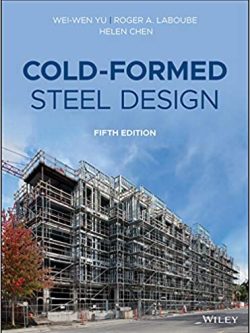Specifications
| book-author | Raymond Ian Gilbert, Neil Colin Mickleborough, Gianluca Ranzi |
|---|---|
| publisher | CRC Press; 2nd edition |
| file-type | |
| pages | 699 pages |
| language | English |
| asin | B01MTGAH65 |
| isbn10 | 1466573104; 0367027917 |
| isbn13 | 9781466573109/ 9780367027919 |
Book Description
A great deal more information is required for the design of structures in general, and the design of prestressed concrete structures in particular, than is included in the relevant building codes. It is essential to have a solid understanding of the structural behavior at all stages of the loading process. This textbook provides a thorough and up-to-date guide to the structural design process by providing a detailed description and explanation of the behavior of prestressed concrete members and structures when subjected to service loads as well as ultimate loads. Additionally, the text presents a detailed description and explanation of the relationship between service loads and ultimate loads.
The Design of Prestressed Concrete to Eurocode 2; 2nd Edition; (PDF) textbook bases a significant portion of its content on first principles and relies solely on the principles of mechanics and the properties of concrete and steel; the text also includes numerous worked examples. However, where the design requirements are specific to a code, this book refers to the provisions of Eurocode 2: Design of Concrete Structures, and where possible, the notation is the same as in Eurocode 2. In addition, where the design requirements are not code specific, this book follows the same notation as Eurocode 2. The Australian Standard for Concrete Structures (AS3600-2009) is being followed by the writing of a parallel volume.
Beginning with an overview of the fundamentals, the text then moves on to more in-depth discussions of more complex issues that are relevant to contemporary prestressed concrete structures. Students in their final years of undergrad and graduate school, as well as practicing engineers, who are interested in gaining a comprehensive understanding of the design of prestressed concrete structures can benefit from this book. It is written in an easy-to-read style and maintains the clear and concise explanations that were in the first edition. However, the content has been extensively reorganized, as well as significantly expanded and updated. New chapters have been added that cover design procedures, actions and loads, prestressing systems and construction requirements, connections and detailing, as well as design concepts for prestressed concrete bridges. The topic of serviceability is developed quite a bit throughout this whole thing.
Over the past thirty-five years, each of the authors has been conducting research and instructing students on the behavior and design of prestressed concrete structures, and the new edition of the book that is currently being proposed reflects this wealth of experience. The active and long-term involvement of Professor Gilbert in the development of standards for concrete buildings and concrete bridges has been of great benefit to the work and has contributed significantly to its success.
Reviews
“The analysis progresses from basic principles to more complicated topics such as long-term creep, shrinkage effect, and cracking,” the book's introduction states. “The book is organized in a logical sequence that progresses from simply support beam to continuous beam and then 2-way slabs.” — Neil Tsang, from Coventry University in the United Kingdom
“It is a first-rate ebook that should be useful to both practitioners and students who are working toward their master's degrees. The ebook is organized and written in a way that is very easy to understand. It is especially appealing that there is such an emphasis placed on providing clear explanations of physical behavior. — Robert Vollum and the Imperial College of London
“There are many diagrams and worked examples; the second edition benefits from a clearer layout and some photographs; the first edition only has diagrams,” the author writes in the second edition. It refers to the provisions of Eurocode 2 (EN 1992-1-1:2004) and other relevant EN Standards in those instances where the design requirements are code-specific. — The Concrete Society; the United Kingdom
“This ebook provides a comprehensive and in-depth coverage of all aspects of analysis and design for both students and practicing engineers,” the author writes in the book's description. Explanations of structural behavior and design concepts are provided in terms that are straightforward and simple to comprehend and follow. The requirements of the Eurocode as well as their application are fully explained and illustrated by worked examples. — Tony Threlfall, Consultant and Author from the UK













Reviews
There are no reviews yet.